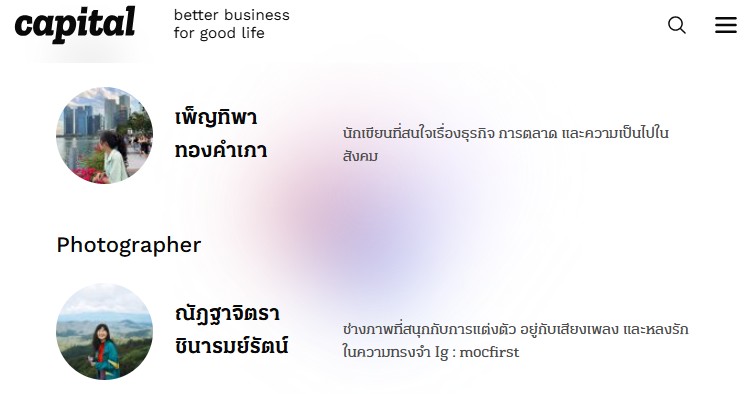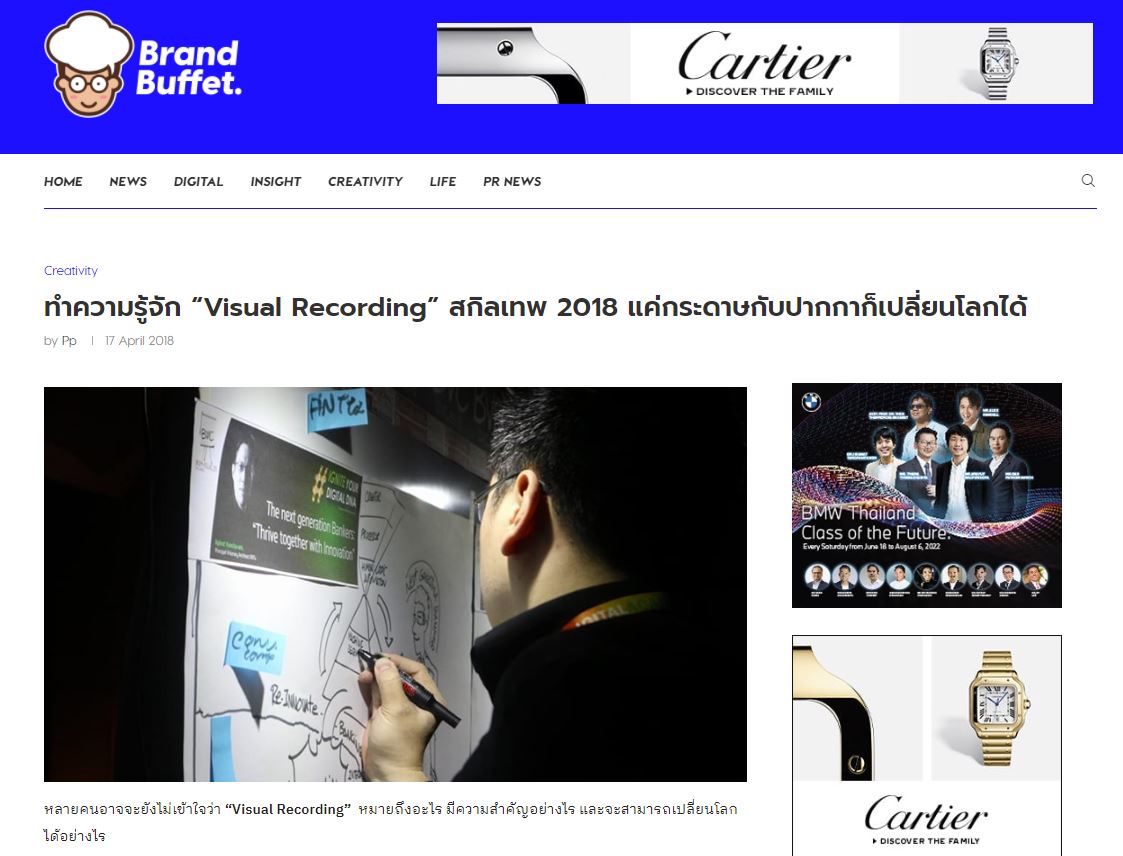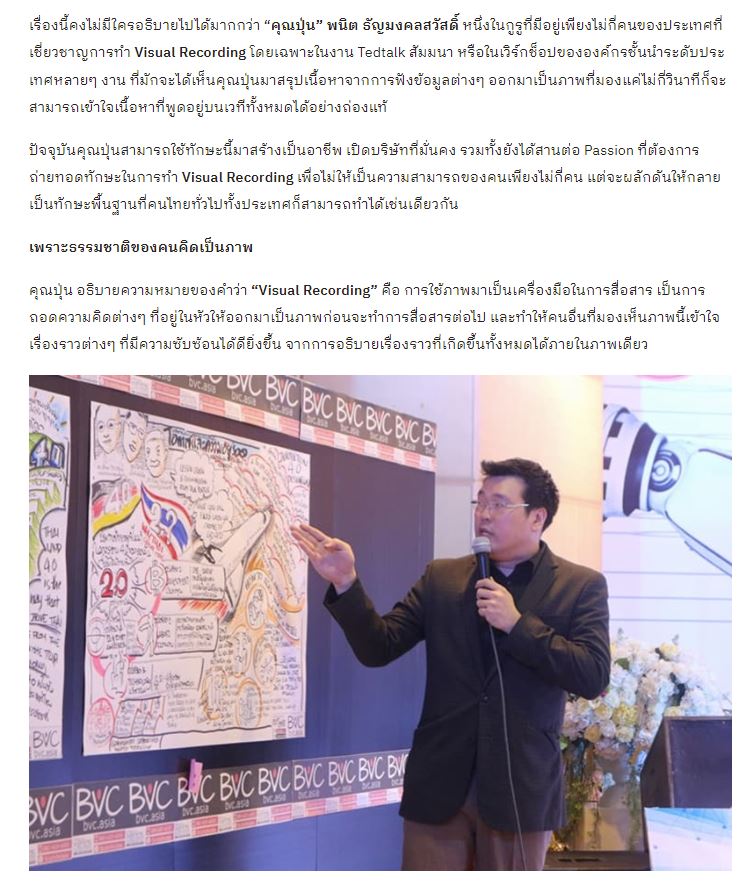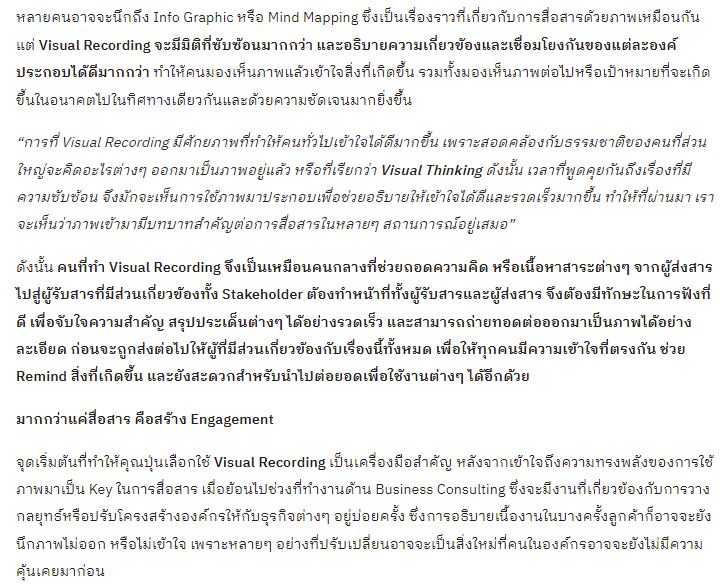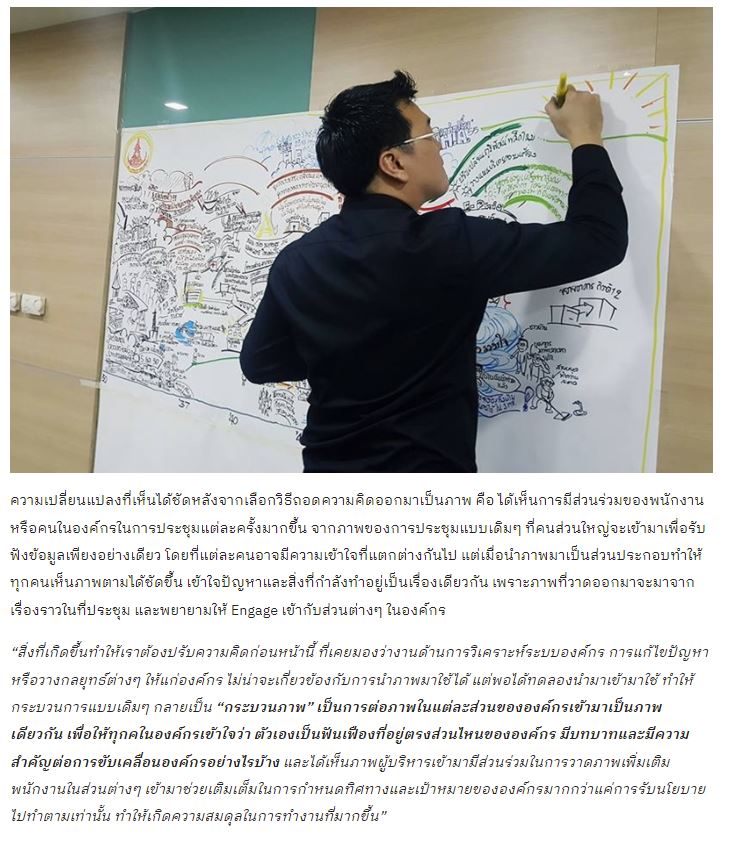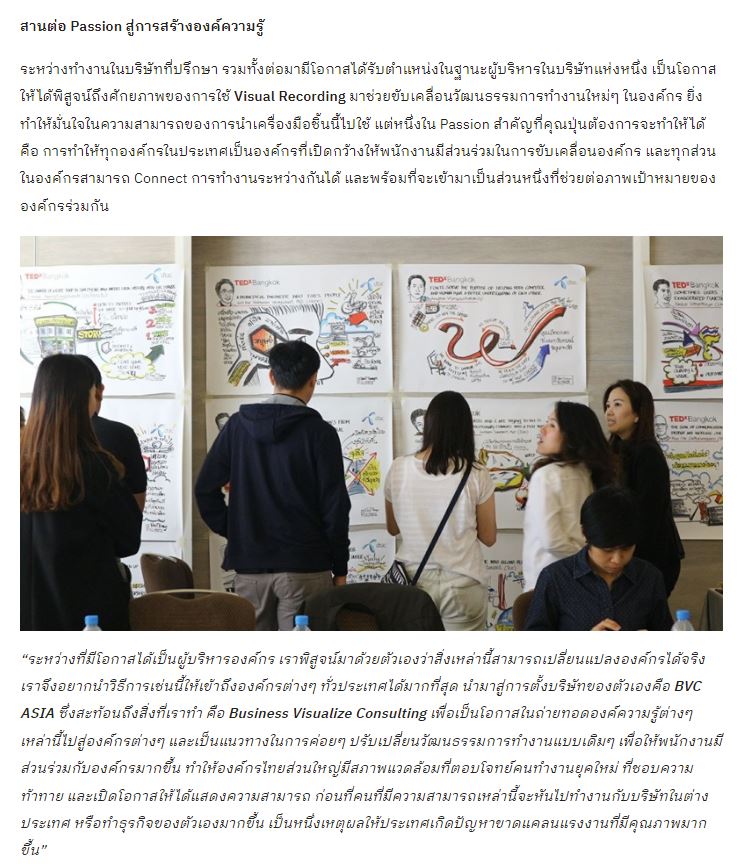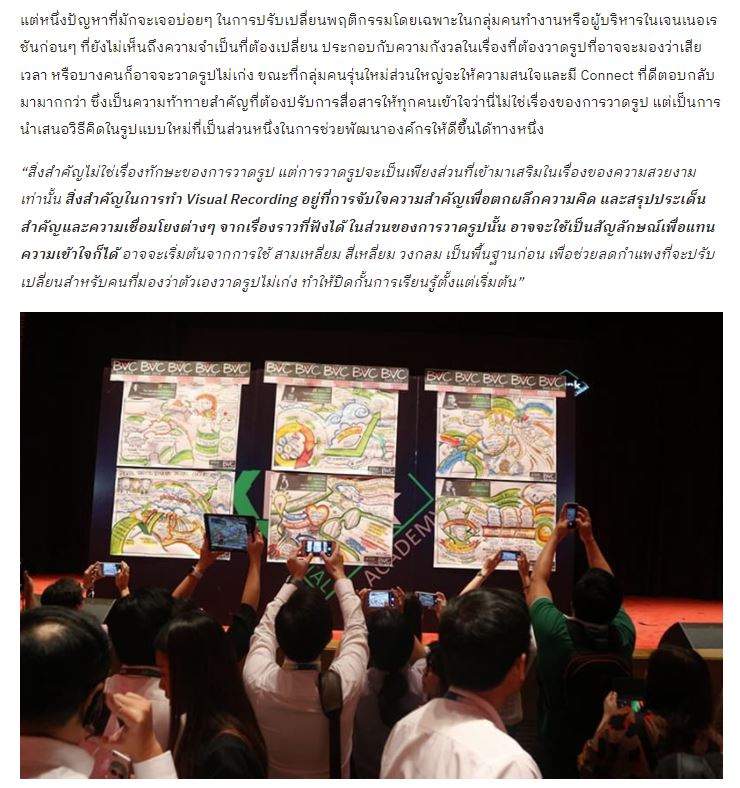คุยกับ ‘BVC Asia’ ผู้ใช้ Visual Recording แปลงประเด็นบนเวทีสัมมนาออกมาเป็นภาพสดๆ บทสัมภาษณ์ กับ Capital Read
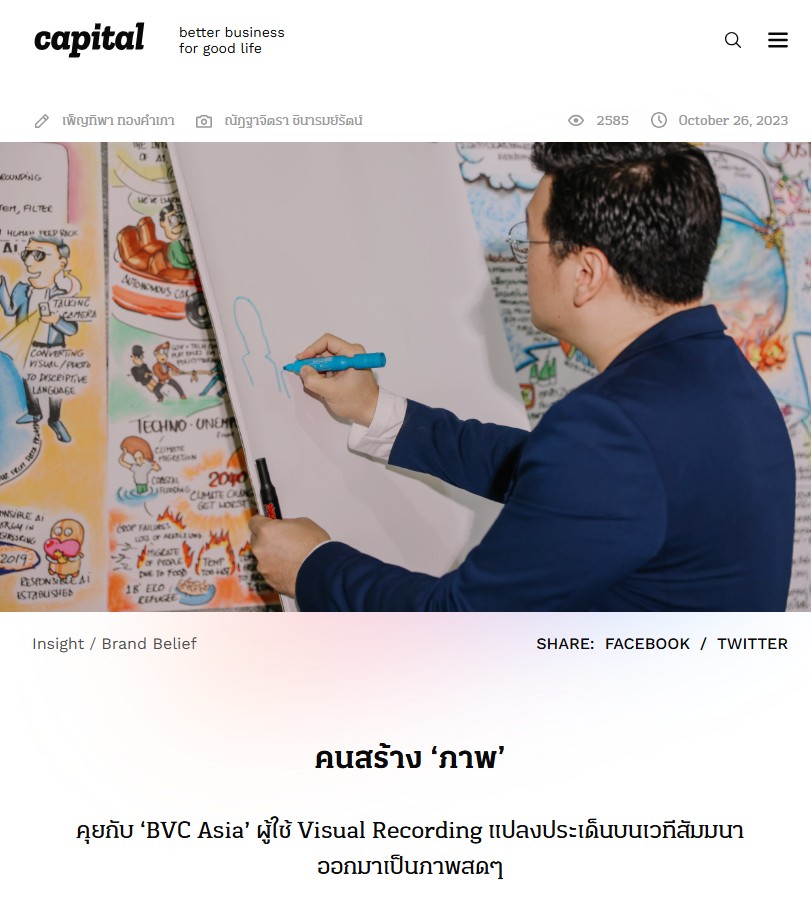
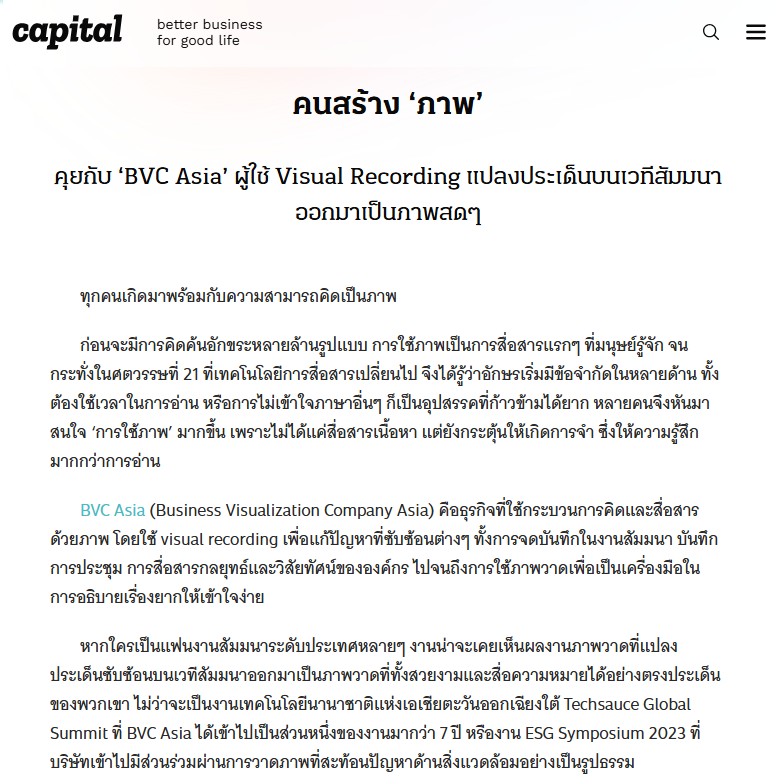
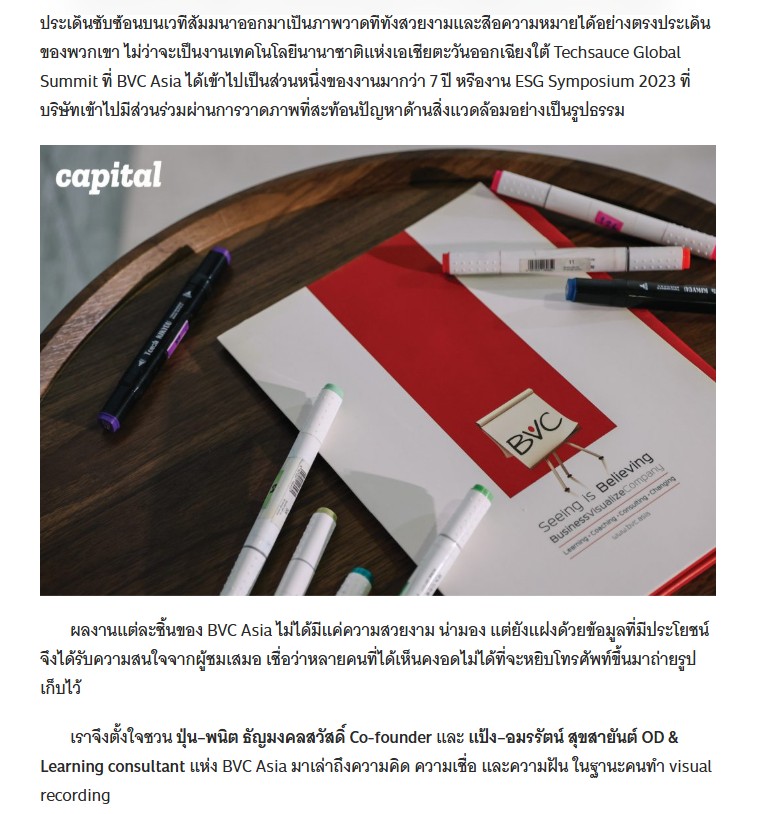
Each piece of work by BVC Asia is not only visually appealing but also embedded with useful information, which consistently attracts the audience’s attention. Many who see their work can’t help but pull out their phones to take photos and keep them.
We therefore invited Poon – Panit Thunmongkolsawat, Co-founder, and Pang – Amornrat Suksayan, OD & Learning Consultant of BVC Asia, to share their thoughts, beliefs, and dreams as visual recording creators.

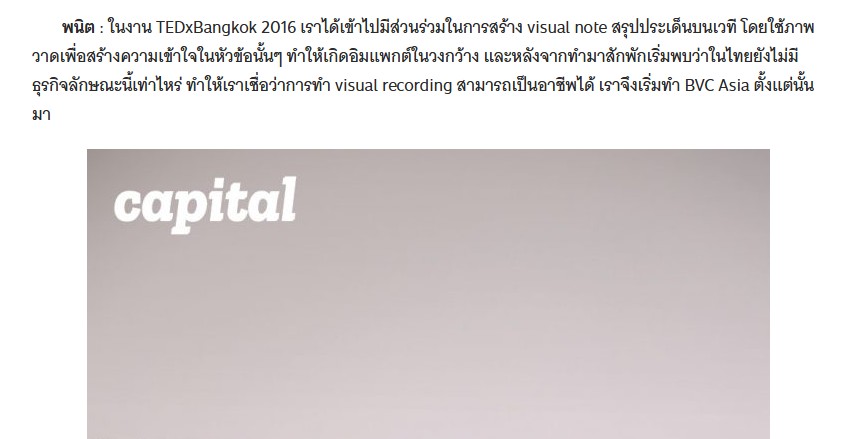
Amornrat: Before seriously working in this field, I worked in organizational and personnel development, where visualization or using images as a communication tool was already part of the work. I felt that this method of communication through images could be developed into a business. In 2016, we had the opportunity to do visual recording for TEDxBangkok for the first time — a major event. Participating in that event was like the official launch of BVC Asia as well.
Panit: At TEDxBangkok 2016, we were involved in creating visual notes summarizing the key points on stage using drawings to enhance understanding of the topics. This had a wide impact. After working in this area for a while, we realized that there were very few businesses like this in Thailand. This made us believe that visual recording could be a viable profession, so we started BVC Asia from then on.


Amornrat: Most people thought visual recording was just drawing pictures. Our challenge was to create understanding — to make people realize it’s not just about making beautiful drawings, but about conveying information in a clearer way. It’s a combination of thinking and drawing. We wanted our work to connect with business as a communication tool, a way to discuss and exchange ideas. This method was still new to Thai people, who were used to just using PowerPoint. We wanted to change the traditional communication mindset.
Panit: In this field, I see the challenge mainly in handling information. Every time we work, we get new knowledge and data that we need to update for the audience. We want to convey this information through drawings quickly, using keywords that immediately convey the content. The difficulty lies in being the first to input this information into people’s minds — to become their mental image or memory.
Therefore, each image we create to capture key points must be complete in content, colorful, and contain symbols or visuals that make it memorable. Even someone from another country who doesn’t understand Thai can look at our work and sense what the image is trying to communicate.
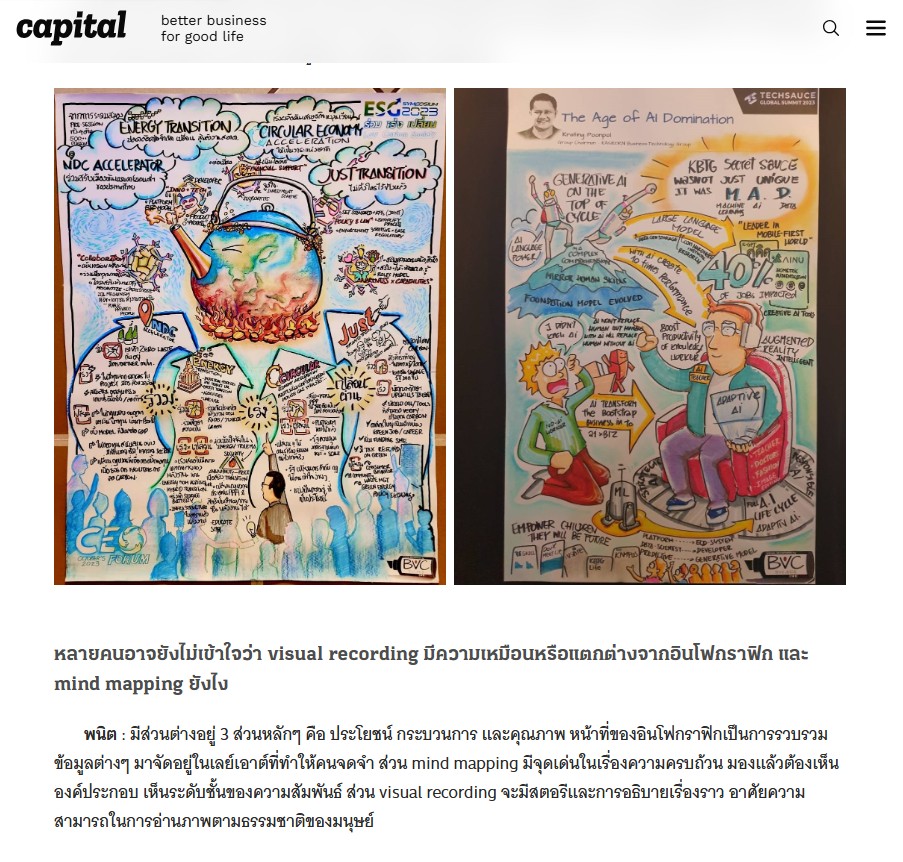
Panit: There are three main differences: purpose, process, and quality. Infographics collect various pieces of information and organize them into layouts designed to help people remember. Mind mapping excels in showing completeness—it lets you see components and the hierarchical relationships between them. Visual recording, on the other hand, tells a story and explains concepts by leveraging humans’ natural ability to interpret images.
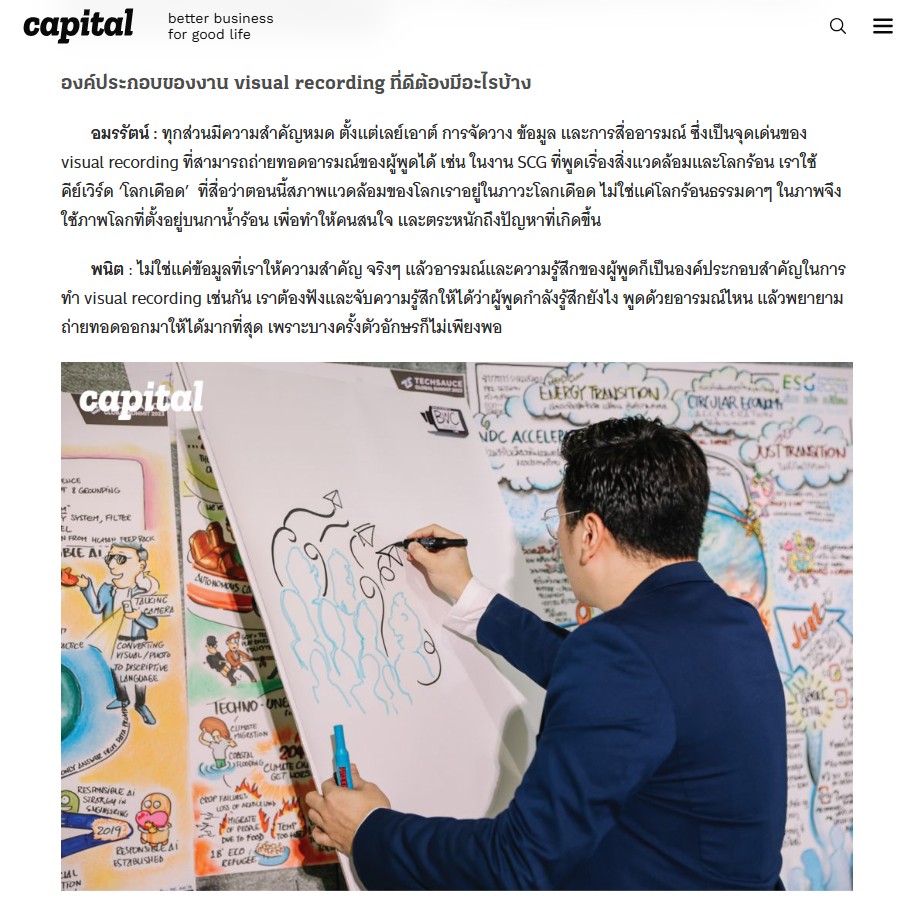
Amornrat: Every part is important—from layout, arrangement, and information to conveying emotion. A key strength of visual recording is its ability to express the speaker’s emotions. For example, in an SCG event discussing the environment and global warming, we used the keyword “Boiling Earth” to convey that the world’s environmental situation is more severe than just “global warming.” The image showed the Earth sitting on a boiling kettle, which grabbed people’s attention and raised awareness about the issue.
Panit: It’s not just the information that matters; the speaker’s emotions and feelings are also a crucial element in visual recording. We have to listen carefully and sense how the speaker feels and what emotion they’re expressing, then try to convey that as much as possible. Sometimes, words alone are not enough.
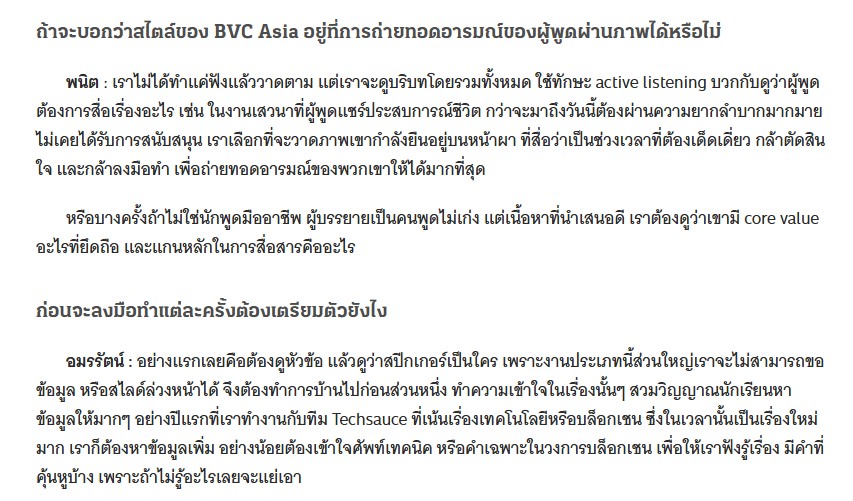
Panit: We don’t just listen and draw blindly. We look at the whole context, using active listening skills combined with understanding what the speaker wants to communicate. For example, at a panel discussion where the speaker shared life experiences, explaining how they overcame many hardships without support, we chose to draw an image of them standing on a cliff—symbolizing a moment of determination, courage to decide, and take action—to convey their emotions as fully as possible.
Sometimes, if the speaker is not a professional orator and may not speak well but presents valuable content, we look for their core values and the main message they want to communicate.
How do you prepare before starting each visual recording?
Amornrat: First, we look at the topic and who the speaker is. For this type of work, we usually can’t get information or slides in advance, so we have to do some homework. We prepare by deeply understanding the subject—wearing the mindset of a student and gathering as much info as possible. For instance, in our first year working with the Techsauce team, which focused on technology and blockchain—a very new topic at that time—we had to study technical terms or jargon to be able to understand the content and recognize familiar words. If we don’t know anything, it would be very difficult.
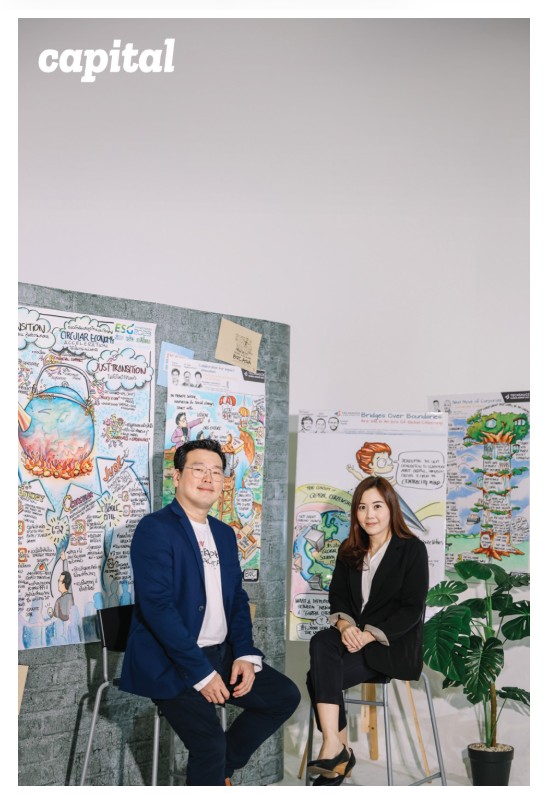

Panit: We encounter issues quite often—so much that it’s become normal (laughs). If the speaker introduces new points or talks about topics we’re unfamiliar with, we have to quickly search for information on the spot. Everything must be done fast and with composure. That’s why we prepare as much as we can in advance—like company logos, event logos, speaker names, and session titles.
During the work, we divide tasks within the team—for example, a layout team, a listening and data collection team, and a drawing and coloring team. Each team has different responsibilities. The listening and data team is responsible for understanding the overall direction of the information. If the data were an ocean, there would be deep and surface-level information. We have to filter and select the most useful data so the audience gets what they expect in a short time. And if they take photos of our work, it must contain useful information—not just big or trendy words.
When drawing on paper, if there are mistakes like misspellings, there are many ways to fix them—such as using correction pens, covering with white paint, or sticking paper overlays. We believe mistakes can happen, but we must stay calm, fix them as seamlessly as possible, and double-check spelling. Our work requires precision, speed, and accuracy.


Amornrat: For every job we do, we have to be extremely focused and well-prepared. We need to know how long each section will be and what kind of information to expect. Everything has to be systematic. In the beginning, we felt a lot of pressure because it’s a tough job where every second counts. We constantly watch the clock. If time is really tight, we’ll first jot down what kind of image should appear in that section and then gradually draw and fill in the details.
Panit: We have a work pattern that we follow. During the first part of the talk, we try to capture the speaker’s direction and emotion—what they are talking about. When we identify key points, we write each one on a separate post-it note. By the second part, we already know which pieces of information relate to which key points. The third and fourth parts are when we draw and color, while the listening team continues to gather information.
Every job comes with new challenges. For example, sometimes speakers introduce new points continuously, so we have to rethink and decide which information to include. Another issue is when the speaker finishes but the visual is not complete—the key points are all presented, but the drawing isn’t fully filled because there’s not enough information to fill the space. When this happens, we look at the speaker’s emotions and add symbols or icons that convey those feelings instead.
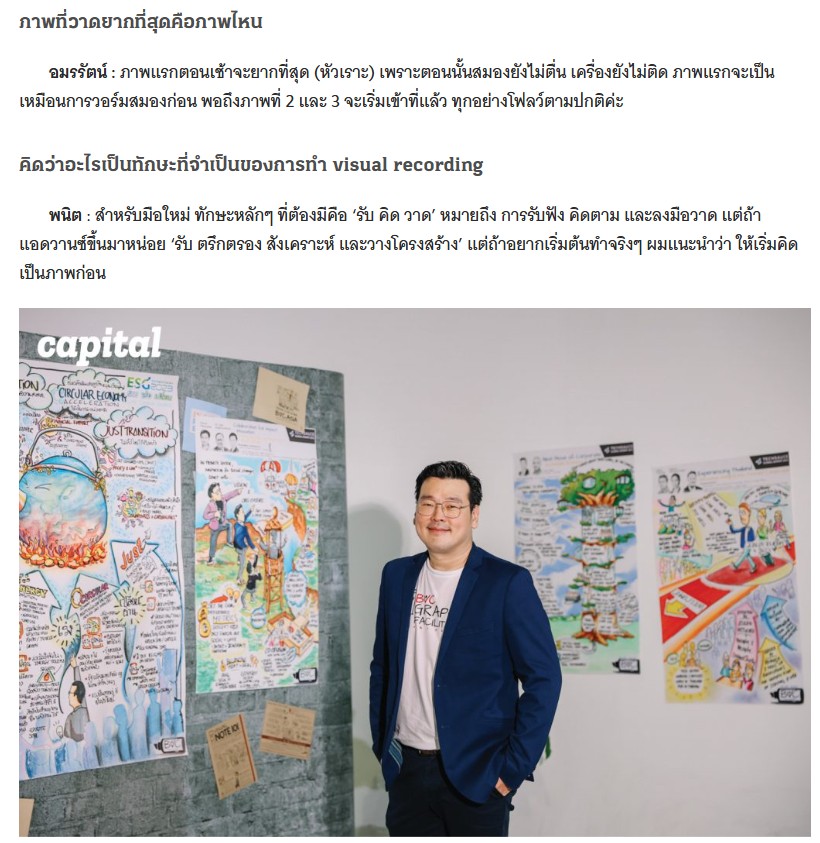
Amornrat: The first drawing in the morning is the hardest (laughs) because the brain isn’t fully awake yet. It’s like a warm-up for the brain. By the second and third drawings, everything starts to fall into place and flow smoothly.
What do you think are the essential skills for visual recording?
Panit: For beginners, the main skills are “Receive, Think, Draw,” which means listening, processing, and then drawing. For more advanced practitioners, it’s about “Receiving, Reflecting, Synthesizing, and Structuring.” But if you want to start, I recommend beginning by thinking in images first.
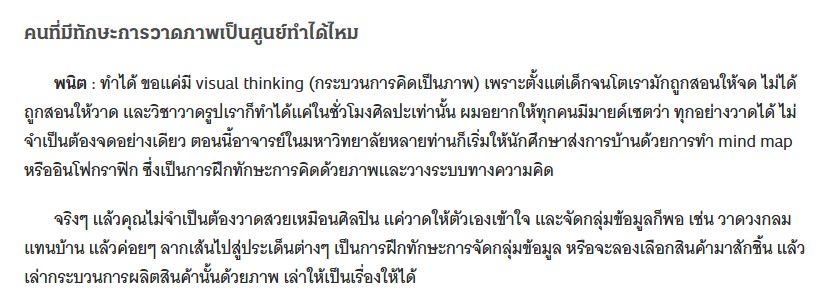
Panit: Yes, absolutely. All you need is visual thinking—the ability to think in images. From childhood to adulthood, we’re often taught to take notes, not to draw, and art classes are usually limited to just a few hours. I want everyone to have the mindset that everything can be drawn—it’s not just about writing notes. Nowadays, many university professors encourage students to submit assignments as mind maps or infographics, which train visual thinking and systematic organization of ideas.
Actually, you don’t have to draw beautifully like an artist. Just draw in a way that you understand yourself and organize the information. For example, draw a circle to represent a house, then connect lines to different topics—this trains your skill in grouping information. Or try choosing a product and illustrate the production process in images—telling the story visually.
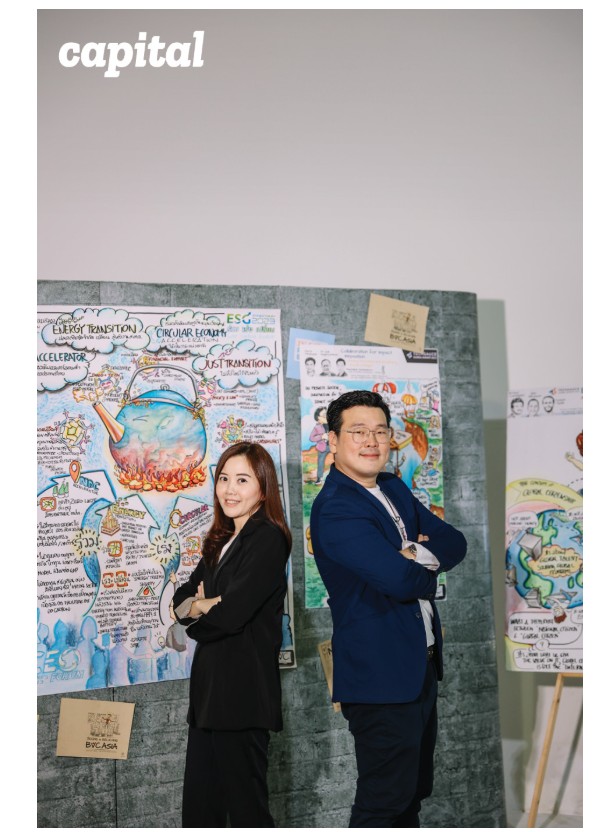
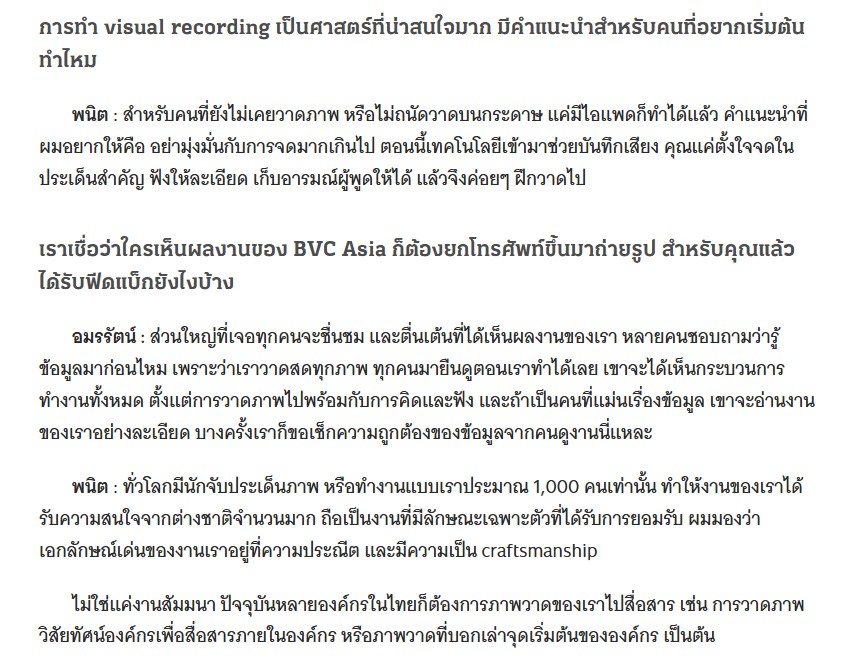
Panit: For those who have never drawn or are not comfortable drawing on paper, just having an iPad is enough. My advice is not to focus too much on note-taking. Nowadays, technology can help record audio, so just concentrate on noting the key points, listen carefully, capture the speaker’s emotions, and then gradually practice drawing.
We believe everyone who sees BVC Asia’s work takes out their phone to take pictures. What kind of feedback have you received?
Amornrat: Most people are very impressed and excited to see our work. Many ask if we had the information beforehand because we draw everything live. Everyone stands and watches us work, seeing the entire process—from drawing while thinking and listening. And if someone is an expert on the topic, they will study our work closely. Sometimes we even ask the audience to verify the accuracy of the information.
Panit: Worldwide, there are only about 1,000 people who do visual recording or similar work like ours, so our work attracts a lot of international attention. It’s a unique type of work that’s highly respected. I think our distinctive quality lies in the meticulous craftsmanship.
It’s not just for seminars anymore. Many organizations in Thailand now want our drawings to communicate internally—for example, illustrating organizational visions or telling the story of the organization’s beginnings.

Amornrat: We work with a wide range of industries including finance, banking, retail, government, state enterprises, and real estate. It depends on the products and services of each company because visualization is not limited to any particular type of organization—every organization can communicate through images.
Panit: Nowadays, many executives have a good mindset and want all employees to see the same picture. Using visuals helps employees understand what’s in the leader’s mind or what others are thinking. For example, in a medical school with many departments, if all the doctors sit down to discuss, they might have difficulty understanding each other. But with visuals, communication becomes easier. Instead of many PowerPoint slides, drawings allow everyone to see the same image.
When you go into an organization to work, what do you do?
Amornrat: Usually, we conduct workshops with employees depending on the organization’s needs. If it’s about organizational culture, we talk to employees at all levels. If it’s strategic, we might focus more on team leaders. In every organization, we have templates tailored to various business situations.
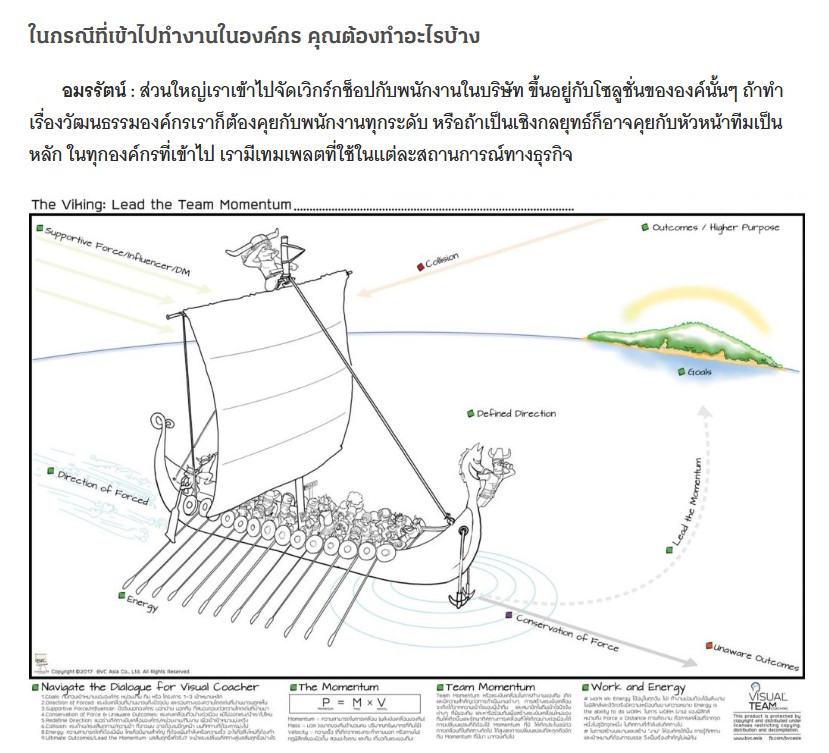

What is the difference between drawing to communicate within an organization and drawing at seminars?
Amornrat: The drawing process is not much different. Nowadays, every department recognizes that communication through visuals is essential, whether it’s internal communication or seminars. The main goal is the same: to simplify complex topics and communicate effectively with a large audience.
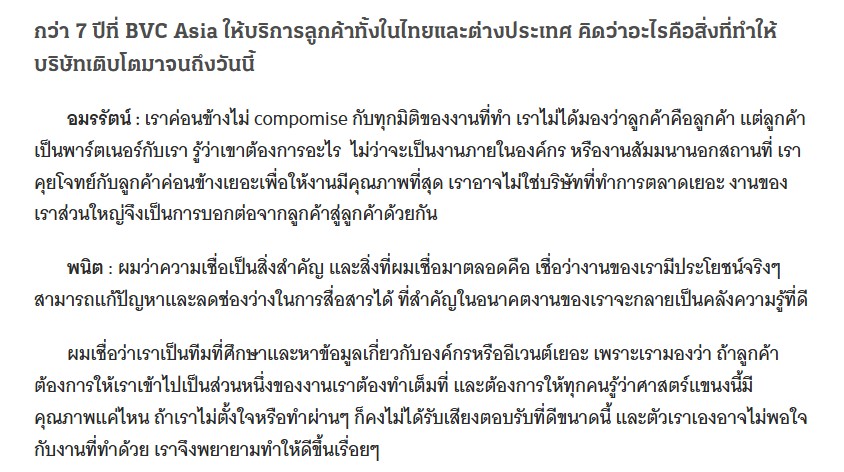
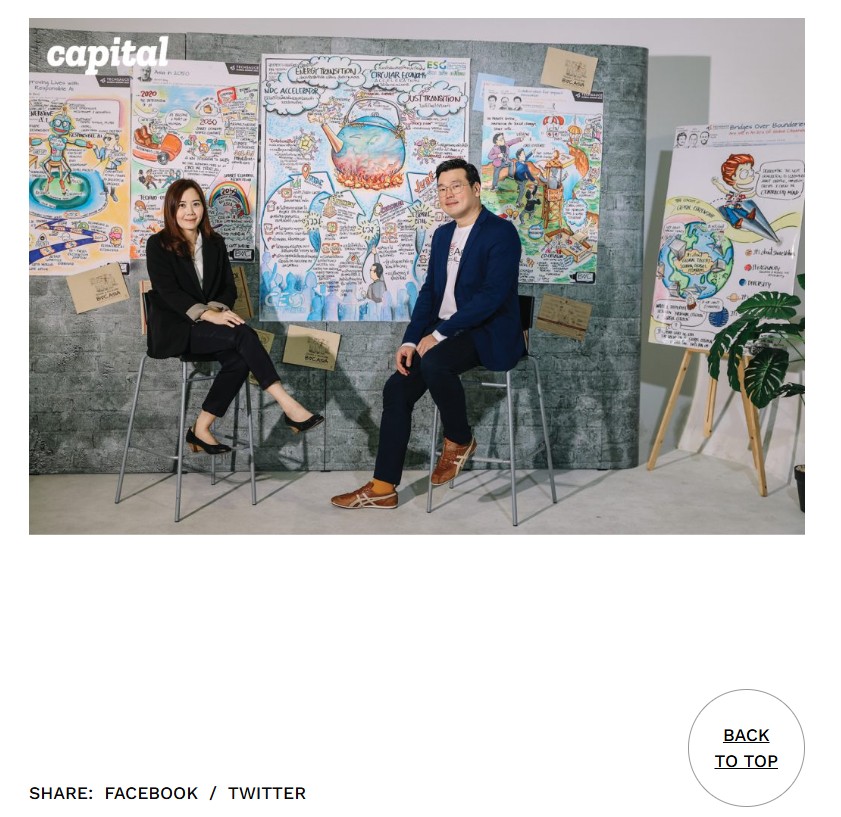
Amornrat: We are quite uncompromising in every aspect of our work. We don’t see clients just as clients but as partners. We understand what they need—whether it’s internal organizational work or off-site seminars. We have in-depth discussions with clients to ensure the highest quality. We may not be a company that heavily markets itself; most of our work comes through word-of-mouth recommendations from client to client.
Panit: I believe that belief is crucial. What I’ve always believed is that our work truly provides value—it solves problems and closes communication gaps. More importantly, I believe our work will become a valuable knowledge repository in the future.
I believe we are a team that studies and researches organizations or events extensively because we see that if clients want us to be part of their event, we have to give our best. We want everyone to know the quality of this discipline. If we weren’t committed or just did a superficial job, we wouldn’t receive such positive feedback, and we ourselves wouldn’t be satisfied with our work. So, we continuously strive to improve.
อ้างอิง จากเว็บไซต์ https://capitalread.co/bvc-asia/
